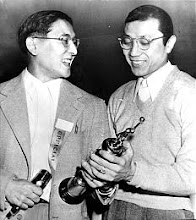G. Allen Johnson, Chronicle Staff Writer
Friday, August 13, 2010
Lawson Sakai has been an American since his birth in the United States 86 years ago. His parents immigrated from Japan, but he never learned to speak Japanese fluently and he has never met his relatives in Japan.
And yet, after Japan's bombing of Pearl Harbor in 1941 hastened the United States' entry into World War II, Sakai was effectively no longer a U.S. citizen.
"In 1941, I was 18 years old," said Sakai, who lives in Morgan Hill. "I was American. I wanted to join the military. I was told I could not because they had reclassified my draft status from 1A to 4C - which meant I became an enemy alien overnight.
"They took away all my civil liberties, I could not join any branch of the military until February of 1943 when they formed the 442nd, and the only military unit we could join was the 442nd."
That thousands of Japanese Americans, many of whom were imprisoned along with their families in internment camps, voluntarily joined the U.S. Army and fought for the Allies in World War II is astounding to many. And fight they did. The 442nd Infantry Regiment - along with an offshoot, the 100th Infantry Battalion - holds the distinction of being the most decorated unit of its size and service in U.S. military history. The 442nd and 100th were known as the "Go For Broke" regiments.
Opening today
It puzzles Japanese people as well, and that's why a Japanese director, Junichi Suzuki, has made a documentary, "442 - Live With Honor, Die With Dignity." The film opens in San Francisco today as part of a slate of films and events that commemorates the end of World War II 65 years ago this month.
Suzuki's movie prominently features Sakai, who fought in France and Italy, several other 442 veterans, including Sen. Daniel Inouye, D-Hawaii, and others knowledgeable about Japanese American issues, such as actor George Takei. In the film, Suzuki's crew joins a group led by Sakai in a visit to the French town of Bruyères, which the 442nd liberated. The town holds remembrances each year and erected a statue of a Japanese American soldier.
Suzuki also uses combat and newsreel footage, old photographs, and interviews with survivors and their families in attempting to put the legacy of the 442nd into a modern context.
"In Japan, we don't know about the Japanese immigrant history during World War II," said Suzuki, 58, during a recent screening with Sakai in Japantown.
Sakai said he is pleased with the film, and said it could be illuminating for its Japanese audiences.
"Many of the people in Japan don't understand what the Nisei (the second generation of Japanese immigrants) did," said Sakai, who serves as president of the Friends and Family of Nisei Veterans. "Since the Nisei were very obedient to the Issei parents, who immigrated from Japan, we carried over many of the traditions and very personal feelings.
"You might say we were very 'Japanese-y,' but we were very American. So there was no question that the Nisei would fight for the United States, and I think it's very difficult for the Japanese to understand why the same group of people could be so different."
Difficult for Americans, too. Despite the Van Johnson film "Go For Broke!" in 1951, which starred many of the 442 veterans, the Japanese American contributions to the war effort went largely unnoticed. It took until Aug. 2 of this year for the U.S. Senate to approve a bill to award a Congressional Gold Medal to Japanese American soldiers. It is expected to pass in the House in September.
After the war
The postwar years were difficult for Sakai, as they were was for many Japanese Americans - heck, many Americans in general - as decommissioned troops began to reintegrate into the workforce.
Sakai met his wife, Mineko, in 1946. He worked with farming organizations, mainly at a strawberry processing plant in California, quit and started a travel agency in San Jose and has been retired since 1990. Along the way, he and Mineko, who was also at the screening, raised four children and have seven grandchildren.
"For about four or five years, the press was anti-Japanese, radio - everything you read or heard," Sakai said. "It was like, 'You got rid of 'em, don't let 'em come back.' When we started to filter back in 1945, there was a lot of opposition. One of my platoon sergeants, his home in Auburn (Placer County) was burned down while he was still overseas. Things like that happened. It was tough to get over that. It was really tough, the prejudice."
'442 - Live With Honor, Die With Dignity':
A documentary by Junichi Suzuki about the 442nd Infantry Regiment, a company of Japanese American soldiers who fought for the United States in Europe during World War II. Included among the subjects interviewed is 442 veteran Lawson Sakai of Morgan Hill.
Today through Thursday at Viz Cinema, 1746 Post St., S.F. (415) 525-8600. www.vizcinema.com. Also playing is "Toyo's Camera," Suzuki's 2007 documentary about World War II internment camp photographer Toyo Miyatake.
E-mail G. Allen Johnson at ajohnson@sfchronicle.com.
http://sfgate.com/cgi-bin/article.cgi?f=/c/a/2010/08/13/DD2C1ERGJC.DTL
This article appeared on page F - 1 of the San Francisco Chronicle



